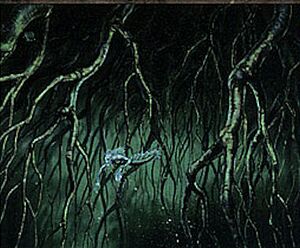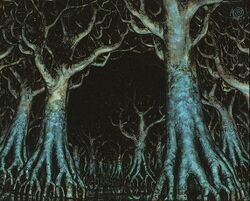Skyshroud Forest
| Skyshroud Forest | |
|---|---|
| Information | |
| Plane | Dominaria |
| Colors |
|
| Type | Forest |
| Part of | Keld, Icehaven, the Domains |
| Formerly part of | Rootwater on the plane of Rath until the Rathi Overlay |
| Scryfall Statistics | |
|
37 artworks | |
Skyshroud Forest is a dense forest in Keld on the island of Icehaven, part of the Domains on the plane of Dominaria, transferred there from Rootwater on the plane of Rath during the Rathi Overlay.
Description
During the Temporal crisis of Dominaria, the forest was remarkably healthy compared to the rest of Keld, but it was still tired and twisted. The trees were alive, but the wood was soft, weak, and wan. The thickest and tallest trunks were all broken just above thirty or forty feet, with the remaining parts pitted by disease and parasites. The characteristic exposed roots of Skyshroud trees formed a confused tangle of dead, gray tendrils. The roots and the lower half of each tree were covered in a thick vine that appeared to be equal parts plant and fungus. Ghastly yellow tumors hung from the vines like grotesque fruit, like diseased muscle tissue and abscessed internal organs. Sharp, chattering sounds clicked and whistled from the shadows, the sound of chitinous claws and mandibles snapping and scraping against each other.[1]
History
Origin
The Elves of Skyshroud were once very peaceable beings, intent on living only the simplest and most placid of lives upon a floating construct in one of Dominaria's expansive oceans.[2] The elves coexisted with a group of merfolk, and the two races existed as one nation for many years, sharing their skills and resources to improve their mutual lot. The portal that dragged them to Rath snatched a massive body of water along with it.
Rath

The transition between worlds was almost immediate, and it took the elves a few days before they began to suspect that the weird storm above them was far more than a localized magical battle. Though large, the body of water was not sufficient for the needs of both the merfolk and the elves. Their alliance drifted apart as the food dwindled, and their partnership ended abruptly in a bloody battle. The elves realized they were at a disadvantage to the merfolk and so decided to build a new home via magical means. In a matter of months, a new forest had grown, which was called Skyshroud.
At its base, the roots of the trees tangled into an almost solid floor of plant life, and this strange edifice floated upon the water. Over the centuries, the merfolk became savage carnivores (with the help of some judicious genetic alteration by the evincars), and the forest grew to enormous proportions. The roots created a labyrinth beneath the water, choking the home of the merfolk. The merfolk cursed the elves and their new home, named Rootwater. Above, the forest canopy had thickened so that barely any light reached the depths of the forest. This suited the elves, who didn't want to be reminded of the horrors beneath.
During its time on Rath, the extremely dense jungle was also inhabited by several rebellious human tribesmen and druids, most likely of Vec descent, that were allied with the elves against the Stronghold as the forest's thick canopy offered protection against the skyship Predator. It was also home to various creatures such as trolls, wild vampires, and other predators.
Planeshifted to Dominaria
Skyshroud appeared on the frozen wastes of Keld following the Rathi Overlay. When the overlay took place, the jungle began to freeze due to the heat difference between the climates, but it was saved by the planeswalker Freyalise, who cast a spell to keep the forest warm. Following the Invasion, she had relocated permanently to this place. The merfolk may have died off after the overlay.
Temporary loss of magic
When Karona withdrew magic from the world, the barrier protecting the forest from the cold of Icehaven evaporated. For three months, the forest of Skyshroud remained frozen beneath the boreal blue. Icicles hung from the branches, and frost painted the tree bark white. The bugs and beasts that could descend to the ground had done so; those that couldn't had died. The elves shivered in the trees and, upon the suggestion of their Keldon neighbors, had resorted to bonfires. Then, Karona was killed by the Mirari-sword, and white clouds rolled in, covering the blinding blue, and flakes of magic fell on Skyshroud. Wherever those gleaming particles germinated, the ice melted. The forest thawed, and warmth returned. Vines burst through the shells of ice, and new life coursed through them. Trees rustled, drying their leaves in the strange wind. In three months, the elves hadn’t had a single reason to smile. Now, as their warm homeland returned to its old self, they found every reason to dance.[3]
Time Spiral crisis
Skyshroud served as a haven from the ravages of post-Apocalypse Keld thanks to its guardian's magic. Following the resurrection of the slivers on Otaria and their subsequent spread throughout Dominaria, the forest was overrun by the creatures, which Freyalise hoped to use as a source of additional mana.[1] With Karona's life and death, the rift in the fabric of space and time, which had been opened around Skyshroud in the wake of the Rathi Overlay and Freyalise's interference, turned into a mana-consuming time-rift weakening Keld's environment. It also linked Keld to its alternate-reality older version, still dominated by Gathans. Soon, these time-displaced warriors attacked the true Keldons and Skyshroud's inhabitants.
After Freyalise sacrificed herself to close the rift, the mana sustaining the forest weakened, and its inhabitants had to move to another location. The current status of the Skyshroud is unknown.
Gallery
-
Icehaven
In-game references
- Represented in:
- Associated cards:
- Freyalise, Skyshroud Partisan
- Skyshroud Ambush
- Skyshroud Archer
- Skyshroud Behemoth
- Skyshroud Blessing
- Skyshroud Claim
- Skyshroud Condor
- Skyshroud Cutter
- Skyshroud Elf
- Skyshroud Elite
- Skyshroud Falcon
- Skyshroud Lookout
- Skyshroud Poacher
- Skyshroud Ranger
- Skyshroud Ridgeback
- Skyshroud Sentinel
- Skyshroud Troll
- Skyshroud Troopers
- Skyshroud Vampire
- Skyshroud War Beast
- Depicted in:
- Referred to:
References
- ↑ a b Scott McGough (2006), "Time Spiral", Wizards of the Coast
- ↑ Pete Venters (December 1997). "Dominian Chronicles: A Dark Corner of the Multiverse" The Duelist #20, 38-39
- ↑ J. Robert King. (2003) Scourge, Wizards of the Coast. ISBN-13 0-7869-2956-1.



